| ||||
| ||
Beautiful Brenner Pass. Most awestruck travelers do not know its sad history as the path on which the Jews were taken out of Italy to concentration camps and the meeting place of Hitler and Mussolini. The painting evokes the beauty with haunting echoes of the dark purpose the place had in our recent past. Simultaneous day and night reveal a collage of then and now. Transport trains departing the Ghetto of Venice are on the same tracks as the historic Brennerbahn and a modern Italian FS passenger train climbing the pass above golden fields that become a Nazi Swastika. Flags of Poland, Italy, Austria and contemporary Germany fly over the mountains of the far reaching landscape. The charming houses of Brennero morph into Auschwitz as they pass thru the chimney smoke. Faces representing a few of the transported Jewish people appear in the smoke of the Brennerbahn. Onion domes cap the churches as you journey northward and impressive highway bridges and tunnels dominate the valley but mimic in form the horrible ovens. The legacy of the Holocaust still influences our world. It was a profound event full of countless stories, Knowing them, sad though they are, enriches my life in the same way that the arts and education do. I've made 4 artworks that reference the Holocaust at this point. | ||
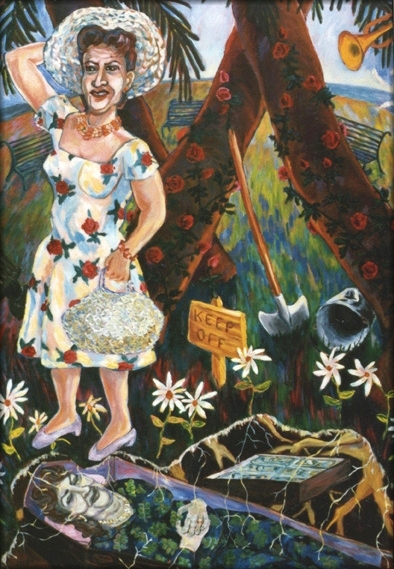 | ||||||
I think that 'Everything’s Comin’ up Roses but Ethel’s Pushin’ up Daisies' has the same basic message about creating your own reality as the Yma Sumac piece. It is about a woman who knew what she wanted to be, chased her own dream and became Broadway’s most famous singer despite having an unconventional voice and delivery. She did not imitate success to succeed, but invented a new style that suited her best. You are going to be dead a long time so live life to the fullest, do with this life what you want to while you can. The painting is full of references to stenographer Ethel Agnes Zimmerman’s glorious show business career as Ethel Merman. The horribly untalented classical singer Florence Foster Jenkins once eloquently said, "some may say that I couldn't sing, but no one can say that I didn't sing." That instantly resonated with me, in fact, it has been my philosophy behind so many of my adventures. Living life to the fullest by following one's own dream born out of passion or want and without the paralizing fear of peers or criticism takes a lot of courage and the rewards so far have outweighed any embarrassment or consequences. There will be painters who can technically paint better, draw better, create more beauty, and convey more profound content than me. There will be men more handsome, clever, successful and funny than me. Yet, I don't let them stop me from trying. And I have no regrets. That is what this painting is really about. Ethel is just the metaphor. | ||||||
Portrait of Ethel Merman | ||||||
Click on painting to enlarge. | ||
Since the beginning I have combined fictional and historical characters to tell stories or rather fables of my own. 'Miss Taken for Evil' honors wrongly vilified women such as the Witch of the West, Lizzie Borden, Lear’s daughters Goneril and Regan, women of heroic nature and deeds yet misunderstood because of gender. For example, I see Dorothy as the real villain. Upon her arrival in Oz she kills the Witch of the East. True, it is an accident, but the inheritance, namely the Ruby Slippers, in any just world would be left to the next of kin, not the careless killer. The Witch of the West has a right to be mad, her sister having just been killed and the killer possessing the witch’s rightful inheritance. Dorothy asks the Wizard to send herhome. The Wizard agrees on the condition that Dorothy and friends bring him the broomstick of the Witch of the West. “But to do that, we will have to kill her to get it,” they reply. “Bring me the broomstick and I’ll grant your request,” the Wizard insists. So Dorothy marches off with her friends to WILLFULLY rob from and kill the woman whose sister she has already done in and then whose beloved slippers she has kept. Who is the bad person here, the independent homely woman living alone without a man or the pretty little thing who murders to get what she wants? What twisted values we must have to admire Dorothy! | ||||
Even in Kansas Dorothy is spoiled and selfish. She comes home complaining that Miss Gulch is going to get the sheriff, “just because she says, ‘Toto gets in her garden and chases her nasty old cat everyday ‘ - but he doesn’t do it EVERY day - just once or twice a week.” As if only a few times a week makes it okay. The farm hand even suggests “when you come home don’t go by Miss Gulch’s place then Toto won’t get in her garden and you won’t get in no trouble, see.” But Dorothy doesn’t see. As a gardener myself I hate it when the neighbor dogs get in my yard and trample my garden. Poor Miss Gulch asks Dorothy time and again to keep Toto away, but Dorothy doesn’t and on this day Toto actually bites the woman on the leg leaving her “all but lame.” That would be too much for me too. I think the witch is totally misunderstood and mistaken for evil. But that awful Dorothy, what bad faults we overlook in the beautiful. | ||
Silver Nantucket Fog | ||||||
| ||||||
'Icarus ' . Icarus has flown to close to the sun and his wings fashioned after a butterfly have begun to melt and tear. He reaches to secure them, the background is in motion as he begins to tumble. He is red with heat and lit by the intense light. This painting is a collaboration with my self. The pose is from a series of one minute gesture drawings made of me that I recued from the bin of a studio and then flipped to create the illusion of the fall. Oil on canvas, 36" x 36" | ||
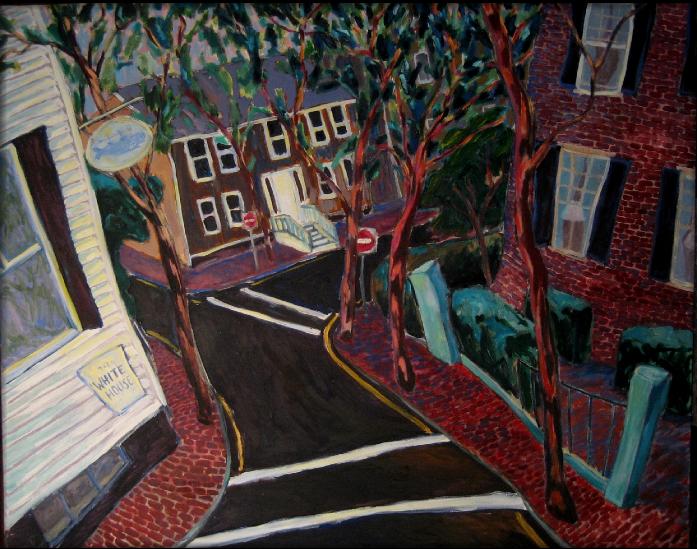 | ||
Coffin House, Nantucket | ||
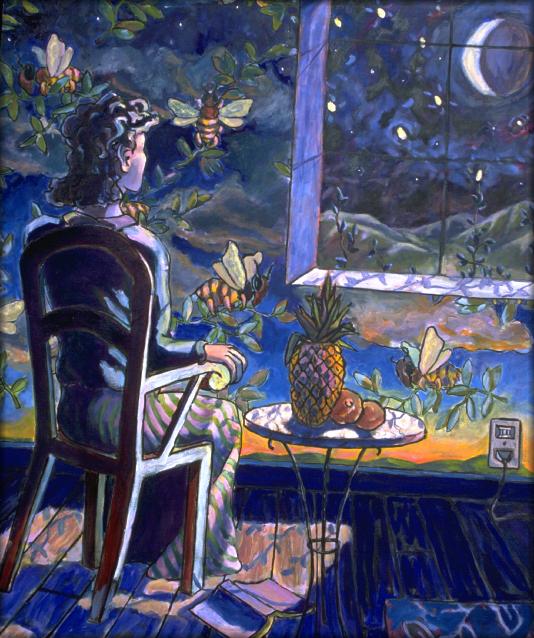 | ||
Barbarini Pineapple Oil on Canvas 48" x 56" | ||
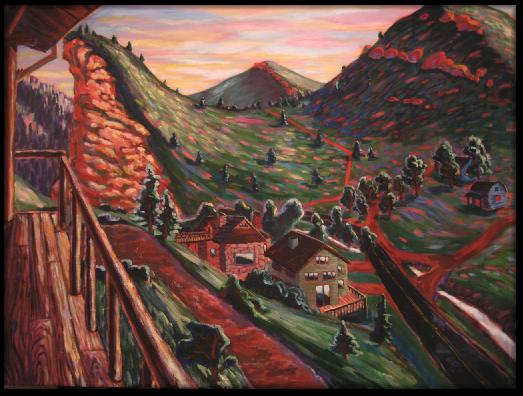 | ||
View from my deck in Colorado. Olde Stage Road and Buckingham Park below. Lefthand Canyon Palisades are the cliff formations at the left. The 2013 floods severly impacted the area. | ||
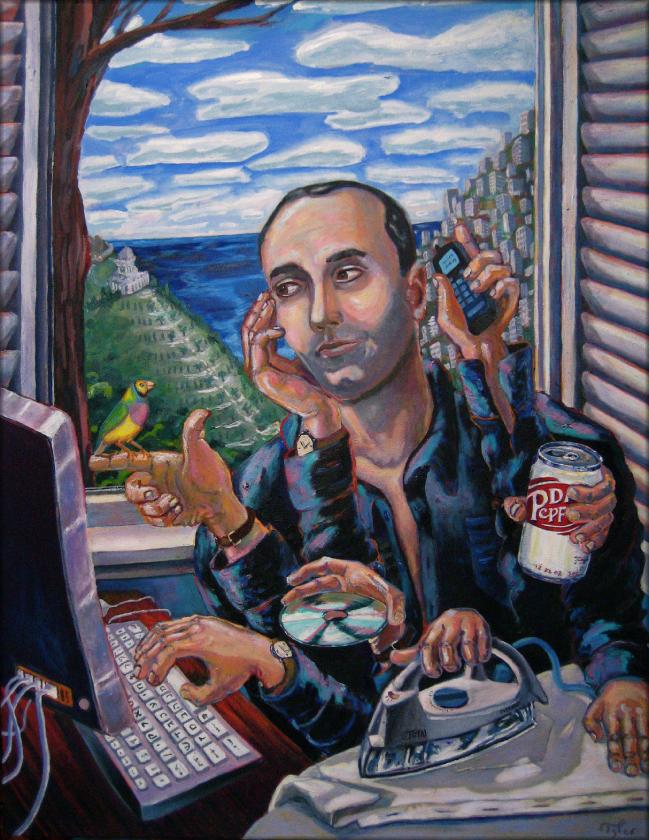 | ||
Memi Sofar Mulitasks in Haifa. The photo does not do this painting justice. One of my best. Memi is always doing a million things at once, talking on the phone while surfing the internet and watching a film. Everything is neatly pressed. When I asked him about whatkind of iron he uses, then looked it up so I could paint it, I found it cost over $200! I was expecting maybe $30. That high price confirmed in my mind I was capturing an importtant part of the essence of his personality by including that detail He raises Gouldian Finches, adores Diet Dr. Pepper, and always had the newest cell phone. In the background is the Baháʼí World Centre and Gardens, Haifa and he Mediterranean Sea. A windowin this house was chipped by shrapnel incoming from Lebanon. Many different peoples have to live together in a very small space, and it is not always in peace. | ||
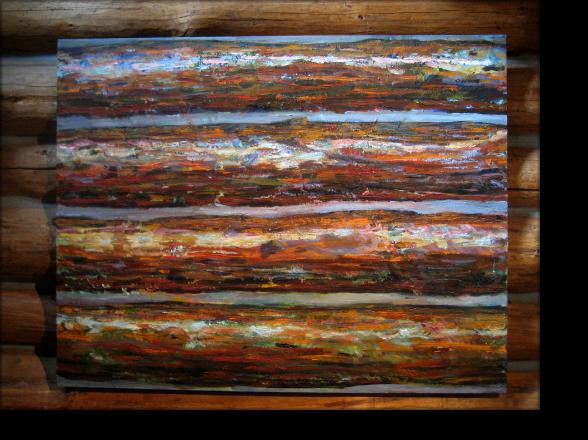 | ||
Logs Site specific work. *An x-ray would reveal a completely different painting underneath the surface." | ||
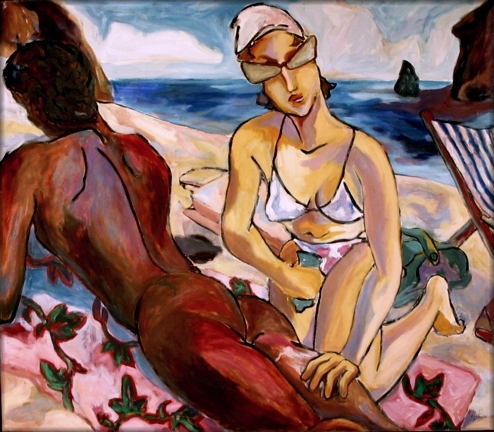 | ||
Coppertone From the Daily Camera 8/17/03: "While the ostensible "stories" of these paintings might veer toward the unpleasant (and, in the case of "Bar Scene," even the grotesque), the paint itself is luxuriously applied, a seductive dance of color and texture on the canvas. This is particularly evident in "Coppertone," an oil that depicts a white woman rubbing suntan lotion on a black man's back. It's easy enough to read a sexual tension into the relationship between these two characters, but what's more satisfying is how Alpern renders the scene. The rich and variable blues of the water shimmer and collide, the flesh tones mingle and merge with the sand, and Matisse-like patterns blossom throughout the composition." Oil on Canvas, 48" x 44" | ||
 | ||
Atop Mapleton Hill Boulder Colo. The enchanting new home of the Sundance Film Festival. The famous Flatirons rock formation rises in the distance. This is a reworked painting I did some years ago. I eliminated the foreground figures and improved various elements. If I hold onto a painting long enough I keep altering it or may paint over it entirely allowing vignettes of the orginal to peek through the surface. | ||
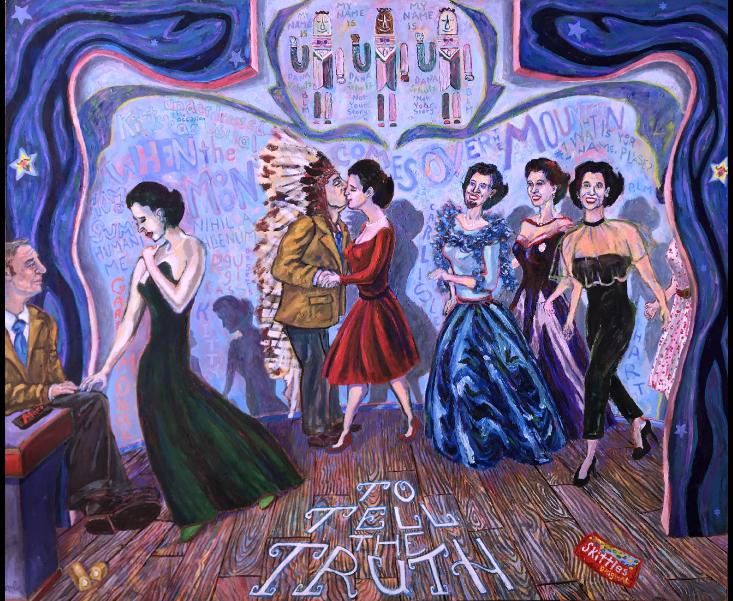 | ||
Click image to enlarge | ||||
"To Tell The Truth" Our values change as a reaction to new cultural awarenesses and sensitivities. Some of the images we are now uncomfortable with were always were racist, but some we find inappropriate were just a product of mainstream culture norms that have since evolved. Context is everything when we look back. With this painting I ask how do we decide what is offensive cultural appropriation today? Who has the right to tell a story or speak up for an injustice? I don't have answers, but I do have questions to pose. And posing questions, inspiring thought and discussion and criticism is what artists do.
This painting is a collage of many moments and controversial incidents and is placed in the visual framework of 1970 stage set of the game show “To Tell the Truth.” The premise of the show is a perfect metaphor to discuss today’s challenges of navigating cultural appropriation and “cancel culture” because the show itself featured contestants deliberately telling stories that were not their own.
Times have changed drastically since the heyday of “To Tell The Truth,” when gracious host Garry Moore could sport a Native American War Bonnet or Headdress to introduce his guest Pawnee Chief Garland James Blaine's story with no intent to show any disrespect to the guest, his culture or the audience. People are a product of their times and ideas and social norms change. It is not fair to judge an artist for different values decades ahead of their time and for circumstances out of their control. Artists, writers and performers who have found themselves questioned or canceled due to the content of their artwork because of changing times or for injustices suffered by people of different identities than their own are referenced in the modern graffiti-like text: Dr. Seuss, Dana Schutz, Kate Smith, Jeanine Cummins, Laura Moriarty and Sam Durant.
Painted text behind Kitty Carlisle and Garry Moore includes Terence’s quote “Homo sum: humani nihil a me alienum.” (I am a man, nothing human is alien to me.) As human beings we share our greatest achievements and worse failings. You don’t have to be Jewish to relate to the holocaust, or black to sympathize with the Black Lives Matter movement, or sexually assaulted to support MeToo. Artists speak up about what issues compel them, no matter what their gender, race, sexuality, culture or societal privilege is. Anne Frank’s words were about universal truths and her legacy is for everyone. References in this painting to Jewish culture and what happened Harvey Milk can be closely associated with my identity, but the Skittles that remember Trayvon Martin and BLM do not. I hope we all can be moved by injustices and not be afraid to speak about them - and to sometimes just listen.
To really understand all that I mean and the autobiographical elements also incorporated in this piece, click here for a detailed explanation of the imagery. *An x-ray would reveal a completely different painting underneath the surface." | ||
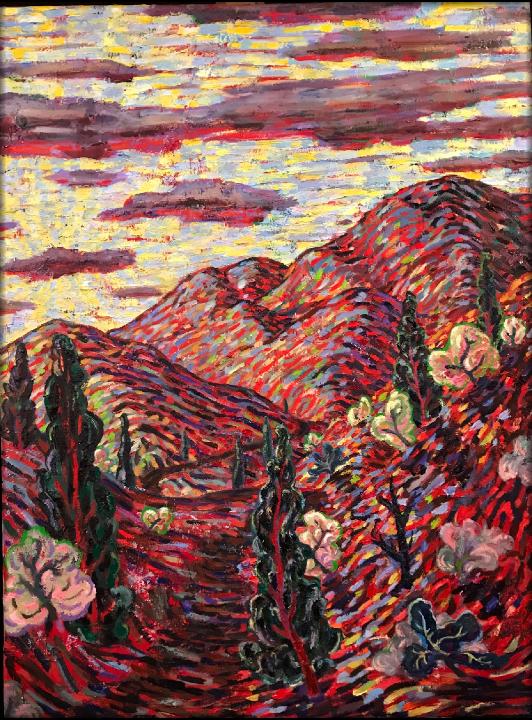 | ||
Red Path Forward The path forward is never straight. | ||
 | ||
